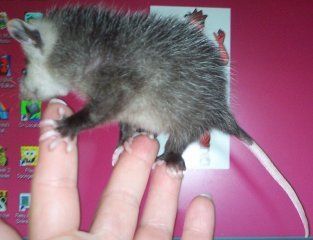- Mar 20, 2008
- 1,793
- 10
- 171
I remember reading posts in here from people that have raised orphaned possums. I can use your help.
Someone brought me a 5 1/2 inch (from nose to butt) male possum. They said mom was on the road dead and this little guy was on the road next to her.
I have been doing some research online and have read that an opossum under 7" long isn't old enough to make it on his own.
His eyes are open and he gets around on his own. I have him inside of a teddy bear hand puppet (like a pouch) and he is asleep right now. I fed him fresh goats milk with an eyedropper and stimulated him to go potty.
When he wakes up I'm going to put a shallow bowl of goats milk in the cage to see if he will eat on his own. I'll put his nose in it....like you would a kitten.
What I need to know is what else to feed him? I have been reading online that catfood is too high in protein and can cause kidney damage.
For those of you who have raised them and kept them...what do you feed? Does he still need a heating pad? Or will his puppet be enough? The temps inside are in the mid 70's.
Any advice would be appreciated. Pictures soon. My daughter has my camera right now. Thanks
Someone brought me a 5 1/2 inch (from nose to butt) male possum. They said mom was on the road dead and this little guy was on the road next to her.
I have been doing some research online and have read that an opossum under 7" long isn't old enough to make it on his own.
His eyes are open and he gets around on his own. I have him inside of a teddy bear hand puppet (like a pouch) and he is asleep right now. I fed him fresh goats milk with an eyedropper and stimulated him to go potty.
When he wakes up I'm going to put a shallow bowl of goats milk in the cage to see if he will eat on his own. I'll put his nose in it....like you would a kitten.
What I need to know is what else to feed him? I have been reading online that catfood is too high in protein and can cause kidney damage.
For those of you who have raised them and kept them...what do you feed? Does he still need a heating pad? Or will his puppet be enough? The temps inside are in the mid 70's.
Any advice would be appreciated. Pictures soon. My daughter has my camera right now. Thanks





